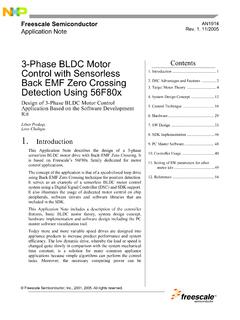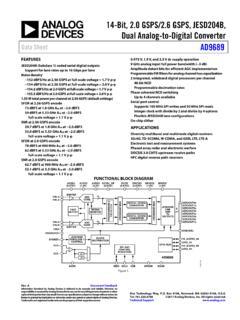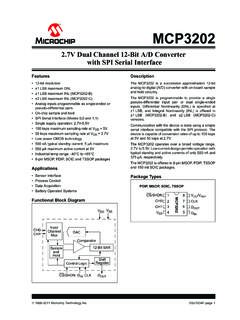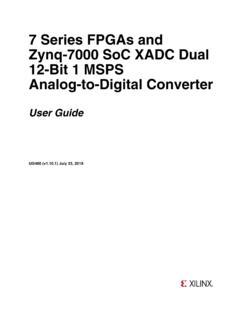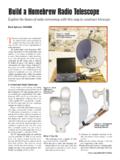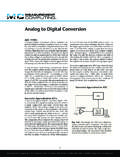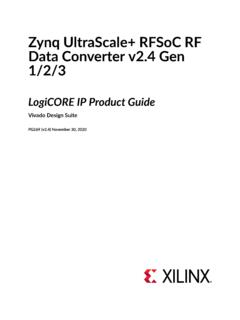Transcription of SECTION 6.1: DIGITAL-TO-ANALOG CONVERTER …
1 Converters CHAPTER 6: CONVERTERS. INTRODUCTION SECTION : DIGITAL-TO-ANALOG CONVERTER . ARCHITECTURES digital -TO analog CONVERTERS (DACs OR D/As) INTRODUCTION KELVIN DIVIDER (STRING DACs) SEGMENTED DACs digital POTS THERMOMETER (FULLY DECODED) DACs BINARY WEIGHTED CURRENT SOURCES R-2R LADDER MULTIPLING DACs SEGMENTED DACs SIGMA-DELTA DACs I/V CONVERTERS DIFFERENTIAL TO SINGLE-ENDED CONVERSION TECHNIQUES SINGLE-ENDED CURRENT-TO-VOLTAGE CONVERSION DIFFERENTIAL CURRENT-TO-VOLTAGE CONVERSION digital INTERFACES DATA CONVERTER LOGIC.
2 TIMING AND OTHER ISSUES INTERPOLATING DACs (INTERPOLATING TxDACs) RECONSTRUCTION FILTERS SIN(X)/(X) (SINC) INTENTIONALLY NONLINEAR DACs SECTION : analog -TO- digital CONVERTER . ARCHITECTURES THE COMPARATOR: A 1-BIT ADC SUCCESSIVE APPROXIMATION ADCs FLASH CONVERTERS SUBRANGING, ERROR CORRECTED, AND PIPELINED ADCs SERIAL BIT-PER-STAGE BINARY AND GRAY CODED (FOLDING) ADCs COUNTING AND INTEGRATING ADC ARCHITECTURES CHARGE RUN-DOWN ADCs RAMP RUN-UP ADCs TRACKING ADCs VOLTAGE-TO-FREQUENCY CONVERTERS (VFCs) DUAL-SLOPE/MULTISLOPE ADCs RESOLVER-TO- digital CONVERTERS (RDCs) AND SYNCHROS BASIC LINEAR DESIGN.
3 SECTION : analog -TO- digital CONVERTER . ARCHITECTURES (cont.). REFERENCES SECTION : SIGMA-DELTA ( ) CONVERTERS HISTORICAL PERSPECTIVE BASICS OF SIGMA-DELTA ADCs IDLE TONE CONSIDERATIONS HIGHER ORDER LOOP CONSIDERATIONS MULTIBIT SIGMA-DELTA CONVERTERS digital FILTER IMPLICATIONS HIGH RESOLUTION MEASUREMENT SIGMA-DELTA ADCs BAND-PASS SIGMA-DELTA CONVERTERS SIGMA-DELTA DACs SUMMARY REFERENCES SECTION : DEFINING THE SPECIFICATIONS SECTION : DAC AND ADC STATIC TRANSFER FUNCTIONS. AND DC ERRORS SECTION : DATA CONVERTER AC ERRORS NOISE IN PRACTICAL ADCs EQUIVALENT INPUT REFERRED NOISE NOISE-FREE (FLICKER-FREE) CODE RESOLUTION DYNAMIC PERFORMANCE OF DATA CONVERTERS INTEGRAL AND DIFFERENTIAL NONLINEARITY DISTORTION EFFECTS HARMONIC DISTORTION, WORST HARMONIC, TOTAL HARMONIC.
4 DISTORTION (THD), TOTAL HARMONIC DISTORTION PLUS NOISE. (THD + N) SIGNAL-TO-NOISE-AND-DISTORTION RATIO (SINAD), SIGNAL-TO-NOISE. RATIO (SNR) AND EFFECTIVE NUMBER OF BITS (ENOB) analog BANDWIDTH SPURIOUS-FREE DYNAMIC RANGE (SFDR) TWO TONE INTERMODULATION DISTORTION (IMD) MULTITONE SPURIOUS-FREE DYNAMIC RANGE SECOND- AND THIRD-ORDER INTERCEPT POINTS, 1 dB COMPRESSION. POINT WIDEBAND CDMA (W-CDMA) ADJACENT CHANNEL POWER RATIO. (ACPR) AND ADJACENT CHANNEL LEAKAGE RATIO (ADLR) NOISE POWER RATIO (NPR) NOISE FACTOR (F) AND NOISE FIGURE (NF) Converters SECTION : DATA CONVERTER AC ERRORS (cont.)
5 APERTURE TIME, APERTURE DELAY TIME, AND APERTURE JITTER A SIMPLE EQUATION FOR THE TOTAL SNR OF AN ADC ADC TRANSIENT RESPONSE AND OVERVOLTAGE RECOVERY ADC SPARKLE CODES, METASTABLE STATES, AND BIT ERROR RATE. (BER) DAC DYNAMIC PERFORMANCE DAC SETTLING TIME GLITCH IMPULSE AREA DAC SFDR AND SNR MEASURING DAC SNR WITH AN analog SPECTRUM ANALYZER OTHER AC SPECIFICATIONS REFERENCES SECTION : TIMING SPECIFICATIONS SECTION : HOW TO READ A DATA SHEET THE FRONT PAGE THE SPECIFICATION TABLES THE ABSOLUTE MAXIMUMS THE ORDERING GUIDE PIN DESCRIPTION DEFINING THE SPECIFICATIONS EQUIVALENT CIRCUITS THE GRAPHS THE MAIN BODY CIRCUIT DESCRIPTION INTERFACE REGISTER DESCRIPTION APPLICATIONS CIRCUITS EVALUATION BOARDS SUMMARY SECTION .
6 CHOOSING A DATA CONVERTER DETERMINE THE PARAMETERS PRIORITIZING THE PARAMETERS SELECTING THE PART BASIC LINEAR DESIGN. CONVERTERS. INTRODUCTION. CHAPTER 6: CONVERTERS. Introduction There are two basic type of converters, DIGITAL-TO-ANALOG (DACs or D/As) and analog -to- digital (ADCs or A/Ds). Their purpose is fairly straightforward. In the case of DACs, they output an analog voltage that is a proportion of a reference voltage, the proportion based on the digital word applied. In the case of the ADC, a digital representation of the analog voltage that is applied to the ADCs input is outputted, the representation proportional to a reference voltage.
7 In both cases the digital word is almost always based on a binarily weighted proportion. The digital input or output is arranged in words of varying widths, referred to as bits, typically anywhere from 6 bits to 24 bits. In a binarily weighted system each bit is worth half of the bit to its left and twice the bit to its right. The greater the number of bits in the digital word, the finer the resolution. These bits are typically arranged in groups of four, called bytes, for convenience. For a better understanding of the relationship between the digital domain and the analog domain please refer to the SECTION on sampling theory.
8 As stated earlier, we shall look at the operation of converters primarily from a black box view. We will concern ourselves less with the internal construction of the CONVERTER and more with its operation. We cannot, however, completely ignore the internal architecture because in many cases it is relevant to operational advantages or limitations. There are a number of works that cover the internal workings of the converters in much more detail (see References). Another point that should be kept in mind is the difference between accuracy and resolution.
9 The resolution of a CONVERTER is the number of bits in its digital word. The accuracy is the number of those bits that meet the specifications. For instance, a DAC. might have 16 bits of resolution, but might only be monotonic to 14 bits. This means that the assured accuracy of the DAC will be no better than 14 bits. Also, an audio ADC. might have a digital word width of 16 bits, but the SNR may be only 70 dB. This means that the accuracy will only be at the 12-bit level. This is not to say that the other bits are irrelevant.
10 With further processing, typically filtering, often the accuracy can be improved. While these terms are similar and sometimes used interchangeably, the distinction between the two should be remembered. We shall examine the DAC first. BASIC LINEAR DESIGN. CONVERTERS. DIGITAL-TO-ANALOG CONVERTER ARCHITECTURES. SECTION : DIGITAL-TO-ANALOG CONVERTER . ARCHITECTURES. DIGITAL-TO-ANALOG Converters (DACs or D/As) Introduction What we commonly refer to as a DAC today is typically quite a bit more. The DAC will typically have the CONVERTER itself and a collection of support circuitry built into the chip.










